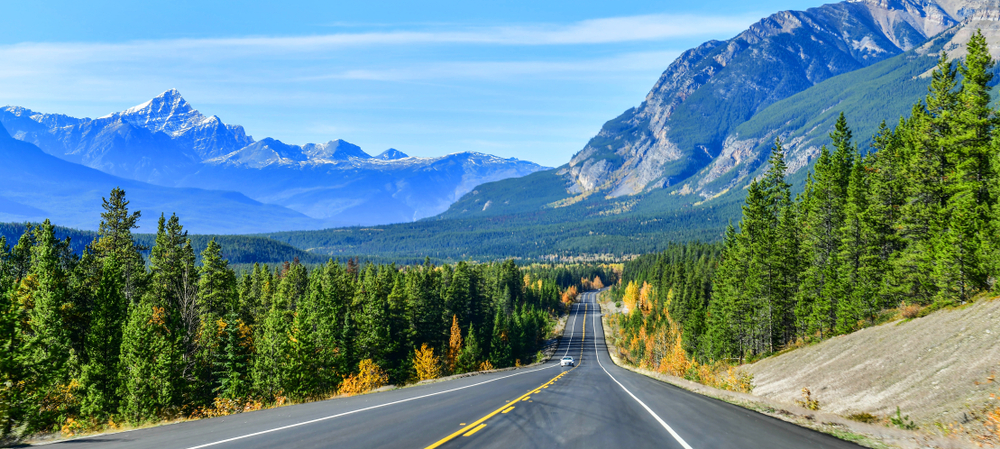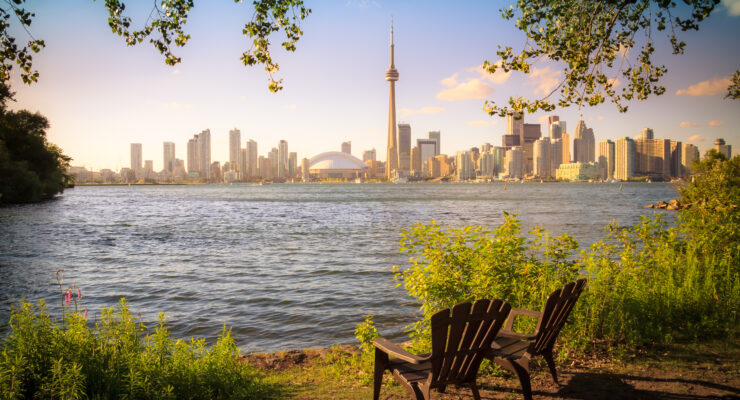Cost of living in Canada at a glance
Is Canada cheap or expensive?
Unfortunately, there’s no easy answer. First, it depends on the cost of living you’re used to—you may find it lower if you’re from Norway and you may find it very high if you’re from Argentina, for example. Second, Canada is a huge country and cost of living varies widely between regions, provinces/territories, and cities. Third, your perception depends on how much money you make—Toronto will feel very expensive if you get by on minimum wage but affordable on a good salary.
Plus, we all have different lifestyles and expectations. “Eating out” can mean grabbing a burger or trying the newest high-end restaurant, “getting around” can be taking public transit or buying your own vehicle, and a full grocery cart can be basics like rice, pasta, and canned food or organic vegetables, meats, and dairy.
That said, your main living expense (and the major recurring one) will be rent. As usual, you’ll pay more in big cities—note that housing is also very expensive “up North” despite plenty of land.
You should also budget for transportation (vehicle or public transit), food, Internet access, a phone plan, entertainment (restaurants, bars, theatre trips, concerts, etc.)—and sales taxes!
Keep in mind that all examples given are estimates.
Most expensive cities in Canada
Most newcomers settle in one of Canada’s three biggest cities—Toronto (population 6.7 million), Montreal (population 4.3 million) and Vancouver (population 2.7 million). Despite their comparatively smaller size, Calgary, Edmonton and Victoria are also expensive.
Good news, there are other cities in Canada that are cheaper! For a lower cost of living, you could consider Quebec City, Halifax or Regina. Ottawa, the national capital, remains surprisingly affordable despite a housing market on the rise.
Don’t forget to explore Canada before settling in a city! Read some of our travel tips for inspiration.
According to Mercer’s Cost of living city ranking, the most expensive Canadian cities are:
- Toronto (ranking 92nd most expensive city in the world)
- Vancouver (ranking 101st most expensive city in the world)
- Montreal (ranking 118th most expensive city in the world)
- Ottawa (ranking 126th most expensive city in the world)
- Calgary (ranking 141st most expensive city in the world)
Canada’s rental market
For more details about each province and territory’s rental market, refer to the dedicated chapters in this guide.
Every fall, the Canada Mortgage and Housing Corporation (CMHC), a Crown Corporation of the Government of Canada, releases the latest housing market data for Canada, including average rent for bachelor, one-bedroom, two-bedroom, and three-bedroom apartments in all the major cities. We used the latest data available to create the map below.
It’s worth mentioning that many experts claim that the CMHC underestimates the cost of housing for Canadian—in most major cities, vacancy rates have been declining and rent rising. The media regularly reports increased pressure on affordable housing. So, take the CMHC data with a grain of salt and compare it to local rent prices listed (e.g. on Kijiji).
You can also get price estimates from PadMapper, a location-based apartment rental search engine, and RentSeeker, an online apartment finder and real estate marketing company. Both almost always have estimates higher than the CMHC.
Not used to local real estate lingo? Learn how to decipher rental ads in our guide to Finding accommodation in Canada!
This map is an easy way to see how different average rent prices are across the country:
Average monthly rent price for a houseshare:
$650-$800
$800-$950
$950-$1,100
$1,100-$1,500
$1,500-$1,800
Over $1,800
In the biggest cities, you will pay more for a more central apartment. Living in the suburbs is usually cheaper but it may require a lifestyle adjustment and other costs elsewhere, e.g. you may need to get a car if your suburb isn’t serviced by public transport. In Canada, the typical suburb is geared towards families, so expect big-box stores and franchised restaurants but few bars and independent dining options.
Rent price is a major factor when looking for a place. However, it’s also important to take into consideration how long you have to commute (Canadian cities can be very spread out); the public transit system (is it available during rush hour only or can you go out at night?); how close relevant shops, businesses and services are; your safety, etc. Don’t forget that it gets cold in Canada—a 30-minute walk to the nearest supermarket is pleasant in summer but hellish in winter.
Food
According to Statistic Canada, the average household spends $10,000 a year on food (groceries and restaurants). Recent statistics suggest a single adult spends an average of $375 per month on food.
Estimating food costs is particularly tricky because it varies widely within Canada, provinces and cities. Generally speaking, Nova Scotia, New Brunswick, Quebec and Newfoundland and Labrador spend less on food, while prices are higher in British Columbia, Saskatchewan and Alberta.
You must have heard a thing or two about North America and junk food… it is true that produce and dairy products tend to be more expensive than in Europe, for instance. Buying local, natural, sustainable or organic food without breaking the bank also requires some research and flexibility.
Shopping around is often the key for healthy and cheap meals. Competition is fierce between large supermarket chains, so it makes sense to look for “weekly specials,” i.e. discounted products in the weekly flyers. You can also buy produce at the market (if available), in international grocery stores (Chinatown, Little India, Greek Town, etc.) or from independent greengrocers. Check out farm-to-table and farmer baskets for alternative options as well.
You will find below a sample from Statistic Canada’s monthly average retail prices for food and other selected products data. Note that all prices are before any discount you may find and they vary from one province to another.
Animal products
- Ground beef, 1 kg: $12.52
- Chicken, 1 kg: $8.04
- Bacon, 500 g: $8.55
- Butter, 450 g: $5.67
- Cow’s milk, 4 L: $6.53
- Carton of 12 eggs: $3.87
- Processed cheese slices, 250 g: $2.77
Produce
- Apples, 1 kg: $4.77
- Bananas, 1 kg: $1.63
- Oranges, 1 kg: $4.12
- Onions, 1 kg: $2.37
- Carrots, 1 kg: $2.46
- Tinned tomatoes, 796 ml: $1.62
- Potatoes, 4.54 kg: $10.33
- Mushrooms, 1 kg: $10.42
Processed food
- Frozen French fries, 1 kg: $3.43
- Sliced bread, 675 g: $3.00
- Canned soup, 284 ml: $1.28
- Peanut butter, 500 g: $2.89
- Cooking oil, 1 L: $4.45
- Canned baked beans, 398 ml: $1.51
- Ketchup, 1 L: $4.17
Costs of car ownership (gas and insurance)
If you’re thinking of buying a car, don’t forget to add registration fees, gas, maintenance and insurance on top of the price of the vehicle itself.
Gas is more expensive in Canada than in the US but it’s still cheaper than in many countries around the world. The price is always in cents per litre and it fluctuates every day. Gas is more expensive in some provinces/territories than in others—keep this in mind if you live close to a border! You’ll pay $1.62 per litre on average. Check the daily updated Retail Fuel Prices by Province for a complete overview of a current gas prices (taxes included).
Car insurance is relatively expensive and where you live can increase your premiums—for instance, insuring a vehicle in British Columbia or Ontario will cost more than in Quebec or New Brunswick. As a newcomer to Canada, most insurance companies won’t acknowledge driving experience abroad and will consider you a “new driver,” so you will pay more.
Make use of
Youset when searching for the best car insurance deals.
Read Buying a car in Canada and Everything you need to know to rent a vehicle in Canada for more info.
Phone plans
Pretty much any traveller (except Australians and Americans) will find Canadian phone plans very expensive. The local nickname for the three main telco companies—Rogers, Bell and Telus? “Robelus”!
Not only is there a lack of competition but many “options” that are included free-of-charge in the rest of the world are offered for a fee in Canada, e.g. call display, voicemail, call forwarding, etc. You’re also charged for both outgoing and incoming calls.
Budget around $50-60 per month for a plan with unlimited minutes and text messages, plus some data. Smaller providers are still owned by the “big three” (Koodo is owned by Telus, Virgin Mobile by Bell, Fido by Rogers) but they are slightly cheaper. Don’t forget that taxes aren’t included… more on that in a second.
In summary:
- Cheaper providers: Fido, Public, Virgin, Wind, Koodo, Mobilicity, Solo Mobile, Freedom Mobile, Fizz, etc.
- Parent companies (most expensive): Rogers, Bell and Telus
- Use free WiFi whenever possible! There are plenty of hotspots available—fast food restaurants, coffee shops, malls, public libraries, etc.
You can try PlanHub’s free tools to find the mobile plan at the best price for each province.
Also, read How to choose a phone plan in Canada for more details.
If you are settling in Quebec, Ontario, British Columbia, Alberta or Manitoba, you can make use of our special deal with
Fizz mobile and get a referral bonus + 10 GB of data + 1 month of free Internet!
Landline, Internet and cable TV
Home phone lines, Internet and cable TV are often “bundled” and even getting rid of some of the services—who needs a landline when you have a mobile phone, and who needs cable when you can stream?—doesn’t necessarily make it a better deal.
The two main telco providers are Rogers and Bell. For a home phone/Internet/cable bundle, you’ll pay minimum $100 per month with a two-year contract with either Rogers or Bell (surprise, surprise… almost as if there was some kind of agreement in effect!). Note that these offers don’t include fibre and Internet usage is not unlimited.
For Internet access only, unlimited Internet with fibre starts at $100 per month.
Smaller and local providers like Distributel offer cheaper, basic plans for $50-$70 per month.
Clothing
As in most places in the world, you’ll find a $20 pair of jeans and a $200 pair of jeans retailing next door to each other—the logic of fashion…
Generally speaking, European brands and fashion (e.g. H&M, Zara, Doc Martens, etc.) are more expensive than in Europe, even if you factor in the exchange rate. Shoes and leather goods (bags, belts, etc.) are also more expensive than in Europe.
On the other hand, American brands tend to be cheaper than in many places around the world—Gap, Tommy Hilfiger, Calvin Klein, Levis, etc. It’s often even cheaper to cross the border and shop in the USA. However, don’t forget you need a visitor visa or a travel authorisation via ESTA to travel to the US under the Visa Waiver Program.
Alcohol, tobacco and cannabis
Taxes on alcohol and cigarettes are high, so both are expensive. For instance, in Toronto, a pack of cigarettes is $15 and a bottle of wine is $19.
Recreational cannabis is legal. Prices vary depending on the province/territory but expect to pay $8 per gram.
Sales taxes
In Canada, prices are always “before tax” and tax is added at the point of sale (i.e. when you’re about to pay). If you only have $1 in your pocket, don’t buy a $1 drink because you won’t have enough to cover the sales tax!
The Canadian sales taxes include:
- the Provincial Sales Tax (PST)
- the Quebec Sales Tax (QST)
- the Goods and Services Tax (GST)
- the Harmonised Sales Tax (HST), a combination of the PST and the GST in some provinces
The tax rate varies based on the province/territory.
The goods and services tax (GST)
This 5% tax is levied by the federal government everywhere in Canada.
No GST is charged on “essential items,” for instance:
- Basic groceries (milk, bread, vegetables, meat, fish, poultry, eggs, coffee, etc.)
- Prescription drugs
- Feminine hygiene products (tampons, pads, menstrual cups, etc.)
Soft drinks, alcohol, chocolate, frozen French fries, pizza, ice cream, cleaning products, over-the-counter medications, toys and hygiene products are all taxed.
The Canada Revenue Agency’s definition of “essential items” can be puzzling—fresh and frozen vegetables aren’t taxed but sandwiches are. When shopping, assume your items will be taxed and don’t try to understand the logic (if you insist, you can read the detailed Basic Groceries memorandum from the Canada Revenue Agency!).
The provincial sales tax (PST)
As the name suggests, it’s levied by the provinces at different rates:
- New Brunswick: 10% (GST+PST = 15% tax)
- Nova Scotia: 10% (GST+PST = 15% tax)
- Quebec: 9.975% (GST+PST = 14.975% tax)
- Prince Edward Island: 10% (GST+PST = 15% tax)
- Ontario: 8% (GST+PST = 13% tax)
- Manitoba: 7% (GST+PST = 12% tax)
- British Columbia: 7% (GST+PST = 12% tax)
- Saskatchewan: 6% (GST+PST = 11% tax)
- Newfoundland and Labrador: 10% (GST+PST = 15% tax)
Alberta, Yukon, the Northwest Territories and Nunavut don’t have a PST, so the only tax charged is the 5% GST.
Prince Edward Island, New Brunswick, Nova Scotia, Ontario, and Newfoundland and Labrador combined the goods and services tax (GST) and the regional provincial sales tax (PST) into a single value added sales tax, the harmonised sales tax (HST). The rate is the same; it’s just one line on your receipt instead of two.
The unofficial tax—the tip!
Restaurant menus don’t include sales tax(es) or the socially mandatory tip, which is around 15-20%. Get used to tipping, even if the practice is weird or foreign to you, because it’s proper etiquette in North America.
So when you’re looking at the menu, mentally add 30% to the price—the 15% tax plus the 15% tip.












 Français
Français English
English




0 comments
{{like.username}}
Loading...
Load more